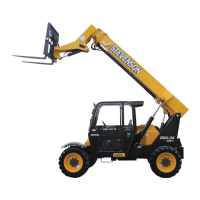913323/CP0112 12 PRINTED IN U.S.A.
Ü ALWAYS wear safety glasses with side shields
when striking metal against metal. In addition, it is
recommended that a softer (chip-resistant) materi-
al be used to cushion the blow. Failure to heed
could lead to serious injury to the eyes or other
parts of the body.
Ü DO NOT refill the fuel tank when the engine is
hot. Allow engine to cool down before refilling to
prevent hot engine parts from igniting the fuel if it
should spill or splash.
Ü DO NOT smoke while filling the fuel tank, while
working on the fuel or hydraulic systems, or while
working around the battery.
Ü DO NOT fill the fuel tank completely. Allow room
for expansion. Maintain control of the fuel filler
nozzle when filling the tank. Use the correct fuel
grade for the operating season.
Ü NEVER use fuel for cleaning purposes.
Ü DO NOT remove the radiator cap after the engine
has reached operating temperature or if it is over-
heated. At operating temperatures, the engine
coolant will be extremely hot and under pressure.
ALWAYS wait for the engine to cool before
attempting to relieve pressure and remove the radi-
ator cap. Failure to heed this warning could result
in severe burns.
Ü DO NOT loosen or disconnect any hydraulic lines,
hoses or fittings without first relieving hydraulic
circuit pressure. Also, be careful not to touch any
hydraulic components that have been in recent
operation, because they can be extremely hot and
can burn you!
Ü Avoid lubrication or mechanical adjustments with
the machine in motion or the engine operating. If
the engine must be running to make certain adjust-
ments, place the transmission in neutral, apply the
parking brake, place the equipment in a safe posi-
tion, securely block the tires and use extreme cau-
tion.
Ü To ensure continued safe operation, replace dam-
aged or worn-out parts with genuine Gehl service
parts before using this equipment.
Modifications, Nameplates, Markings and
Capacities
Ü Modifications and additions that affect capacity or
safe operation shall not be performed without the
manufacturer’s prior written approval. Where such
authorization is granted, any applicable markings
are to be changed accordingly.
Ü All attachment tools MUST be marked to identify
the attachment tool and the total capacity with the
attachment tool at maximum elevation with the
load laterally centered.
Ü ALWAYS be sure all nameplates, warnings and
instruction markings are in place and legible.
Local government regulations may require specif-
ic decals, which then become the responsibility of
the owner or user to provide.
Safety Guards and Warning Devices
Ü This machine is fitted with a Roll-Over Protective
Structure (ROPS) and Falling Object Protective
Structure (FOPS) in accordance with industry stan-
dards. It is intended to offer protection to the oper-
ator from falling objects, and in case of an over-
turn, but it cannot protect against every possible
hazard. Therefore it should not be considered a
substitute for good judgment and safe practices in
operating the machine. If the ROPS / FOPS struc-
ture is damaged, it must be replaced to restore the
protection it provides.
Ü This machine is equipped with a horn and backup
alarm. The user must determine if operating condi-
tions require the machine to be equipped with
additional devices (mirrors, rotating beacon, etc.)
and be responsible for providing and maintaining
such devices.
Personnel Work Platform (PWP) System
The Mandatory Work Platform Safety Rules must be
adhered to at all times while elevating personnel.
These rules are based on ANSI/ITSDF Standard
B56.6-2005, “Safety Standard for Rough Terrain
Forklift Trucks.” (A copy of this and related standards
can be obtained from the Industrial Truck Standards
Development Foundation, 1750 K Street NW, Suite
SAFETY

